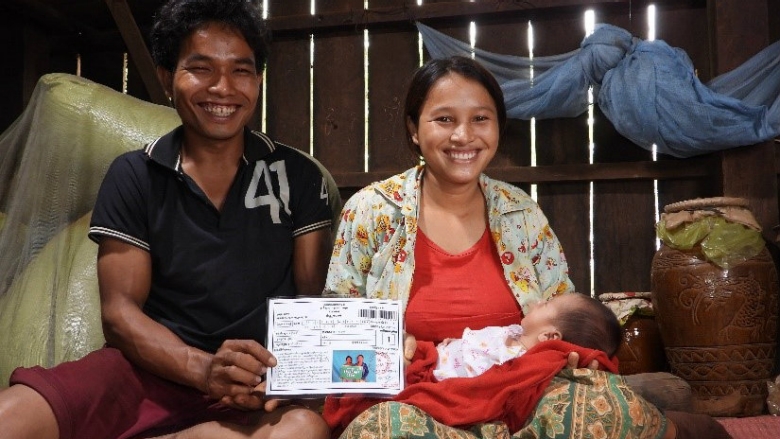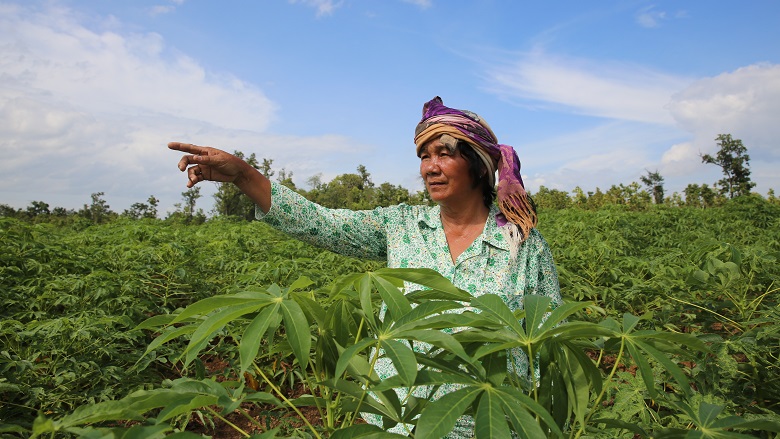Challenge
The drivers of Cambodia’s economic progress to date will not be sufficient going forward, and key reforms are needed to sustain pro-poor growth, attract private investment, and prepare for the digital age. Cambodia’s future prosperity will depend on diversifying its economy, rising higher on global value chains, fostering emerging financial and business sectors, and encouraging entrepreneurship and innovation.
Cambodia continues to have a serious infrastructure gap. Water, sanitation, roads and solid waste management are among the most critical services in need of improvement. And lack of access to year-round all-weather roads impacts food value-chains and access to health, education and other public services. By 2030, Cambodia’s firms are projected to move 4.1 times more goods through country’s highways, ports, airports and warehouses, but the transportation network has not kept pace with rapid economic growth.
Lagging progress on human capital outcomes—knowledge, skills, and health—also poses a challenge to sustaining future growth and maintaining regional competitiveness. The 2017 Human Capital Index (HCI) suggests that a child born in Cambodia today will be only half as productive when grown as she could be if she enjoyed high-quality education, good health and a well-nourished childhood. As Cambodia attempts to move to higher-value added activities and new technologies that require more complex skills, it will need a better trained workforce.
Cambodia’s economy also relies on its rich and diverse natural capital. However, Cambodia’s natural capital is degrading rapidly by unsustainable economic activities, with significant declines in forest cover (21 percent decline between 2006 and 2014), and losses of some 45 percent of the country’s original, natural wetland area. These losses have wide-ranging impacts, including on the productivity of the agricultural and fisheries sectors, hydropower generation, and tourism assets.
Finally, the addressing the weak capacity of public institutions impacts – including the efficiency of public resource management and the ability to deliver public services effectively and accountably – is critical to meeting the evolving needs of both citizens and the private sector.
Approach
World Bank Group (WBG) engagement in Cambodia is well aligned with government development priorities articulated in the Rectangular Strategy for Growth, Employment, Equity and Efficiency. The WBG is helping to address the country’s challenges of limited economic diversification, rapidly increasing urbanization, human capital deficiencies, and infrastructure gaps through the Country Partnership Framework (CPF). The CPF aims to:
- promote state efficiency and boost private sector development and covers a broad set of challenges related to supporting Cambodia’s financial and business sectors, as well as improving the efficiency and effectiveness of the public sector;
- support the development of human capital and address challenges related to education/skills development, delivery of quality health services, access and quality of early childhood development through nutrition, as well as foster collaboration and convergence across strategies and programs in multiple sectors—such as nutrition, water and sanitation and agriculture—to address stunting;
- improve agricultural productivity and strengthen the sustainable use of natural resources and address challenges related to natural wealth management, as well as resilience to climate change.
Finally, the critical cross-cutting theme of strengthening governance and institutions underpins all these efforts and is embedded in all WBG-supported activities in Cambodia.
Results
Following are some of the results achieved since 2016.
Health
The Health Equity and Quality Improvement Project (H-EQIP) has helped accelerate reforms in the health sector, improve social health protection for the poor, expand access to quality and affordable health care services, and create sustainable government institutions for health care management.
Since 2016, the Health Equity Fund (HEF) provided free access to 2.6 million outpatient visits and 190,000 hospital admissions for the poorest people in Cambodia annually. The HEF also provides fee waivers and transport benefits to the poor for priority essential health and nutrition services.
Agriculture and Livelihoods
The Land Allocation for Social and Economic Development Project LASED II has helped improve access to agricultural resources, infrastructure and social services for many citizens in rural communities. Through the project, the government has allocated 17,000 hectares of residential and farm land to 5,141 landless and land-poor families, and so far, 3,232 land titles have been distributed to 1,872 families out of 5,141 families of the project. The project provides roads, builds access tracks to the agriculture plots, delivers infrastructure for household water supply, builds schools and health posts, which are accessible both to project beneficiaries and to the wider community.
Transport
The World Bank-financed Road Asset Management Project (RAMP) supported Cambodia’s investments in both highways and rural roads to improve connectivity and resiliency. As a result, 470 kilometers of Cambodia’s national and provincial road network has been rehabilitated with improved climate resilience and road safety as part of the rehabilitation process. Travel time has been reduced from 2 hours to 1.6 hour per 100 kilometers. The project has also strengthened government capacity and systems for road asset management (including oversight through performance-based maintenance contracts), incorporate disaster risk resilience into its planning framework and enhance road safety measures.
Capital Markets and Access to Finance
The World Bank (in coordination with the International Monetary Fund) has been engaging with the Ministry of Economy and Finance to establish a framework for the development of a domestic government debt market. This paved the way for the International Finance Corporation (IFC), by leveraging the IDA Private Sector Window (PSW), to help open domestic capital markets and local currency financing for the private sector. In 2018, using the IDA PSW Local Currency Facility, IFC enabled microfinance institution Hattha Kaksekar Limited (HKL) to issue a local currency bond of US$30 million equivalent—the first-ever bond issued and listed on Cambodia’s Securities Exchange—to offer more affordable local currency lending products to rural borrowers, especially women. HKL expects to provide approximately 14,000 additional loans in local currency. This WBG approach has opened a domestic debt market and helped set a benchmark for future local currency bond issuances.
Additional results achieved since 2016 in other areas include:
Public Finance Management and Public Accountability systems
- Modern and functioning Financial Management Information System (FMIS) at Ministry of Economy and Finance (MEF) and all provincial treasuries
- The time spent to locate and report on financial data has reduced from two days in 2013 to less than 30 minutes in 2017.
- 67 percent of rural districts are implementing social accountability activities at primary schools, health centers and communes.
Community preschools and reading assessments
- 500 community preschools were established and provided with an operating budget and qualified teachers.
- The early grade reading assessment (EGRA) for students in grades 1 – 3 was mainstreamed into the ministry’s annual operations plan to better assess student progress.
Rice Sector Commercialization
- Milled rice exports increased from 40,000 metric tons in 2010 to 635,000 metric tons in 2017.
- Cambodia now exports rice to 66 countries, an increase from just 30 countries in 2010.
Trade Logistics and Connectivity
- Cambodia’s ranking in Logistics Performance has improved from 129th in 2010 to 73rd in 2016.
- A Road Asset Management System was established and Performance-Based Contracting for road maintenance was piloted and scaled-up by the road agencies.
Bank Group Contribution
The current portfolio includes 12 IDA-financed projects (US$662.6 million), four co-financing trust funds ($45 million) and one small Recipient-Executed Trust Fund (US$2.8 million). The current portfolio includes operations in education, health, environment, road maintenance, agriculture, rural development, and water sectors. Trust funds (TF) are a crucial source of financing to complement IDA lending. The largest TF program in Cambodia is in the Health, Nutrition & Population sector. Trust fund programs for social accountability and service delivery and for strengthening public sector administration are being established.
IFC’s committed portfolio stands at US$243.3 million, with exposure primarily in banks and microfinance institutions.
Partners
Development partners play a significant role in Cambodia’s development program, and Cambodia receives a substantial amount of support from the development community, with Official Development Assistance (ODA) totaling $1.35 billion in 2017. A large spectrum of development partners is present across multiple sectors, and the government leads a number of sector and thematic donor working groups to ensure the appropriate complementarity and division of labor of donor activity and alignment with national priorities. The WBG program complements the work of other development partners, leverages their support, and continues strong collaboration and coordination across the key actors. Examples of key development partners supporting the WB-financed health program are the Government of Australia (through the Department of Foreign Affairs and Trade - DFAT), Government of Germany (through Kreditanstalt fur Wiederaufbau - KfW) and the Government of Republic of Korea International Cooperation Agency—KOICA, as well as from the Government of Japan.
Moving Forward
The Country Partnership Framework for FY19-23 will strengthen empowerment of citizens in the design and implementation of the WBG program. The Royal Government of Cambodia’s Rectangular Strategy Phase V aims to accelerate governance reform and, specifically, encourage people's participation in the development process, as well as the formulation and implementation of various policies. The CPF program will align its activities with this aim to ensure that citizen engagement and good governance cuts across all WBG program interventions to enhance transparency and accountability in the public sector, improve public service delivery, and provide a supportive business climate.

